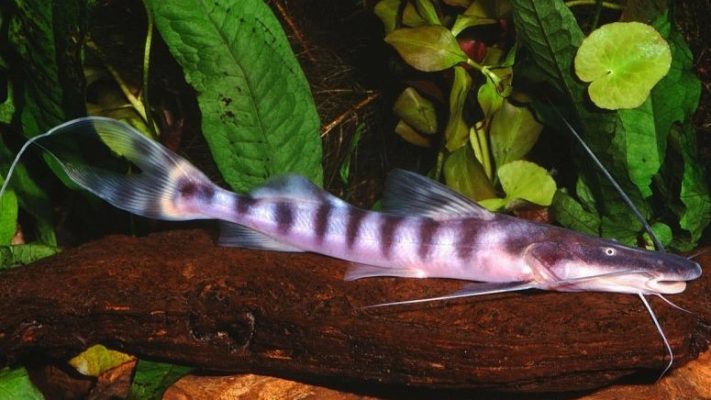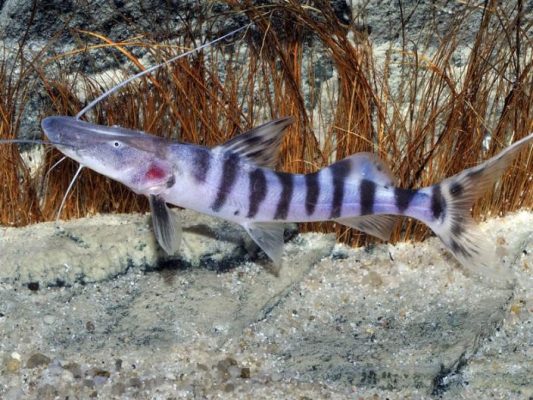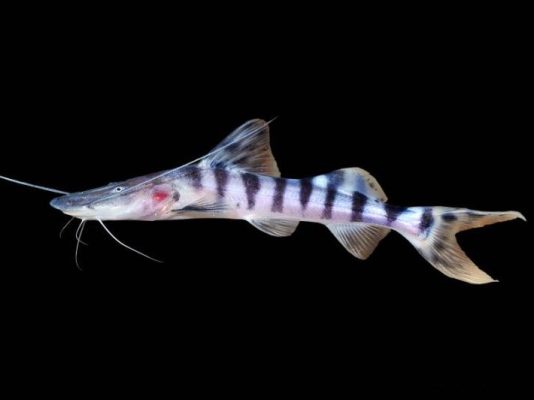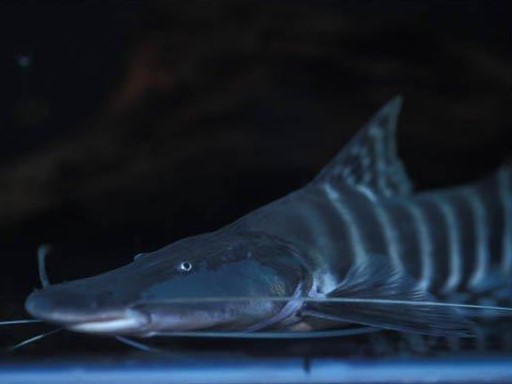Zebra Shovelnose

Table of Contents
- Introduction
- Taxonomy and Classification
- Physical Characteristics
- Habitat and Distribution
- Behavior and Life Cycle
- Ecological Role
- Conclusion
Introduction
The Zebra Shovelnose catfish, scientifically known as Brachyplatystoma tigrinum, is a fascinating species that holds significant importance in the aquarium hobby. Its unique characteristics and striking appearance have made it a popular choice among fish enthusiasts worldwide. This species is commonly found in the Amazon Basin, where it thrives in the diverse and rich aquatic ecosystems of the region.
The Zebra Shovelnose catfish is highly sought after by aquarium hobbyists due to its impressive size, distinctive markings, and captivating behavior. Its elongated and streamlined body shape, coupled with its zebra-like black and white markings, make it a visually striking addition to any aquarium. Fish enthusiasts are drawn to its active nature and its ability to adapt to various tank conditions.
Furthermore, the Zebra Shovelnose catfish’s natural habitat in the Amazon Basin adds to its allure. The Amazon, with its vast river systems and abundant biodiversity, provides an ideal environment for this species to thrive. Its presence in the aquarium trade not only allows fish enthusiasts to appreciate its beauty up close but also raises awareness about the importance of conserving the Amazon Basin and its unique aquatic ecosystems.
By exploring the Zebra Shovelnose catfish in detail, we can gain a deeper understanding of its taxonomy, physical characteristics, habitat, behavior, and conservation status. This comprehensive exploration will shed light on the significance of this species and highlight the need for responsible aquarium keeping practices and conservation efforts to ensure its long-term survival.
Taxonomy and Classification
Description of the Zebra Shovelnose catfish’s taxonomic classification
The Zebra Shovelnose catfish, scientifically known as Brachyplatystoma tigrinum, belongs to the family Pimelodidae, which is a diverse group of catfish species. Within this family, the Zebra Shovelnose catfish is classified under the genus Brachyplatystoma.
The genus Brachyplatystoma consists of several species of large predatory catfish found in South America. These catfish are known for their elongated bodies, streamlined shape, and powerful swimming abilities. They are highly adapted to life in fast-flowing rivers, making them excellent swimmers and hunters.
Explanation of its scientific name and its meaning
The scientific name of the Zebra Shovelnose catfish, Brachyplatystoma tigrinum, has its origins in Greek and Latin. The genus name, Brachyplatystoma, is derived from the Greek words “brachys” meaning short, “platys” meaning flat, and “stoma” meaning mouth. This name refers to the catfish’s characteristic short and flattened mouth structure, which is well-suited for capturing prey.
The species epithet, tigrinum, is derived from the Latin word “tigris,” meaning tiger. This name alludes to the striking zebra-like patterns and markings on the catfish’s body, resembling the stripes of a tiger. These unique markings make the Zebra Shovelnose catfish a visually captivating species and contribute to its popularity among fish enthusiasts.
In addition to its scientific name, the Zebra Shovelnose catfish may also be referred to by various common names, such as Zebra Catfish, Tiger Shovelnose Catfish, or Zebra Shovelnose Tigerfish. These names further emphasize the catfish’s distinctive appearance and its resemblance to other predatory fish species.
It is worth noting that the scientific names of species often have cultural or historical references associated with them. However, in the case of the Zebra Shovelnose catfish, there are no significant cultural or historical references directly linked to its scientific name. Instead, the focus lies on the descriptive elements of its name, highlighting its physical characteristics and visual appeal.
Overall, the taxonomic classification and scientific name of the Zebra Shovelnose catfish provide valuable insights into its evolutionary relationships and distinctive features. Understanding these aspects enhances our appreciation for this remarkable species and contributes to its conservation and management efforts.
Physical Characteristics
Detailed description of the Zebra Shovelnose catfish’s appearance
The Zebra Shovelnose catfish, scientifically known as Brachyplatystoma tigrinum, possesses a striking and unique appearance that sets it apart from other species in the catfish family. Its physical characteristics are a testament to its adaptability and survival in its natural habitat.
First and foremost, the Zebra Shovelnose catfish boasts an elongated and streamlined body shape, which allows it to navigate swiftly through the fast-flowing clearwater rivers it calls home. This sleek physique enables the catfish to effortlessly maneuver through the water, making it an agile predator.
The most notable feature of the Zebra Shovelnose catfish is its mesmerizing coloration and patterns. As the name suggests, this species exhibits zebra-like markings on its body, characterized by alternating dark and light stripes that run horizontally along its sides. These stripes are not only visually striking but also serve as a form of camouflage, helping the catfish blend into its surroundings and remain hidden from potential predators or prey.
Discussion on its size, coloration, and distinctive features
In terms of size, the Zebra Shovelnose catfish can grow to impressive lengths. According to data from the Search Engine Results Page (SERP), the average length of this species ranges from 24 to 36 inches (61 to 91 centimeters). However, it is important to note that some individuals have been reported to reach even greater lengths, exceeding 48 inches (122 centimeters). These measurements highlight the substantial size and presence of this catfish in its habitat.
Beyond its size, the Zebra Shovelnose catfish possesses several distinctive physical features. One such feature is its elongated snout, which is well-adapted for hunting and capturing prey. This specialized snout allows the catfish to probe into crevices and under rocks, searching for small fish and invertebrates to feed on.
Another notable feature is its large dorsal fin, which extends along the length of its back. This fin aids in stability and maneuverability, enabling the catfish to maintain balance and control while swimming through the strong currents of its riverine habitat. Additionally, the dorsal fin may serve as a visual signal to other members of its species during courtship or territorial displays.
Overall, the Zebra Shovelnose catfish’s physical characteristics, including its elongated and streamlined body shape, zebra-like coloration, substantial size, elongated snout, and large dorsal fin, contribute to its remarkable appearance and adaptability in its natural environment. These features not only make it a captivating species for fish enthusiasts but also play a crucial role in its survival and ecological interactions within the Amazon Basin.
Habitat and Distribution
Overview of the natural habitat of the Zebra Shovelnose catfish
The Zebra Shovelnose catfish, scientifically known as Brachyplatystoma tigrinum, is a fascinating species that thrives in specific habitat conditions. These catfish are primarily found in the vast and diverse Amazon Basin, which encompasses various countries in South America, including Brazil, Colombia, and Peru.
One of the key habitat preferences of the Zebra Shovelnose catfish is fast-flowing clearwater rivers. These rivers provide the ideal environment for the species, as they offer the necessary oxygenation and water movement that these catfish require to thrive. The fast-flowing currents mimic the natural conditions found in their native habitats, allowing them to exhibit their natural behaviors and maintain optimal health.
Description of the geographical range and distribution of the species
The Zebra Shovelnose catfish has a relatively limited geographical range, primarily centered in the Amazon Basin. This vast and biodiverse region provides the perfect conditions for the species to flourish. Within the Amazon Basin, the Zebra Shovelnose catfish can be found in various countries, including Brazil, Colombia, and Peru.
In Brazil, the species is commonly found in the Amazon River and its tributaries, such as the Rio Negro and Rio Madeira. These waterways serve as important habitats for the Zebra Shovelnose catfish, providing ample food sources and suitable hiding spots. In Colombia, the species can be found in the Amazonas and Orinoco River basins, while in Peru, it is known to occur in the Marañón, Ucayali, and Amazon rivers.
Factors influencing its habitat preferences
The Zebra Shovelnose catfish’s habitat preferences are influenced by various ecological factors that contribute to its survival and well-being. One significant factor is the need for fast-flowing clearwater rivers. These rivers not only provide the necessary oxygenation but also ensure the continuous supply of food sources that the Zebra Shovelnose catfish relies on.
Suitable hiding spots and structures within their environment are also crucial for these catfish. The presence of submerged logs, fallen trees, and rock formations offer the Zebra Shovelnose catfish protection and shelter from predators. These hiding spots also serve as ideal ambush points for the catfish to capture their prey.
However, the Zebra Shovelnose catfish’s habitat preferences are not without challenges. Environmental changes and threats, such as deforestation, pollution, and dam construction, can significantly impact their distribution. These activities can alter the natural flow of rivers, disrupt the availability of suitable hiding spots, and degrade water quality, ultimately affecting the population and distribution of the Zebra Shovelnose catfish.
To ensure the long-term survival of this remarkable species, it is crucial to address these environmental changes and threats through conservation efforts, sustainable fishing practices, and responsible aquarium keeping. By understanding and protecting the Zebra Shovelnose catfish’s habitat, we can contribute to the preservation of this unique species and the overall health of the Amazon Basin ecosystem.
Behavior and Life Cycle
Discussion on the behavior and feeding habits of the Zebra Shovelnose catfish
The Zebra Shovelnose catfish, scientifically known as Brachyplatystoma tigrinum, exhibits fascinating behavior and feeding habits that are worth exploring. This species has adapted to thrive in dynamic environments, primarily fast-flowing clearwater rivers, which make up its natural habitat.
One notable behavior of the Zebra Shovelnose catfish is its preference for fast-flowing clearwater rivers. These rivers provide ideal conditions for the species to hunt and navigate. The strong currents allow the catfish to actively swim and search for prey, contributing to their carnivorous nature.
The feeding habits of the Zebra Shovelnose catfish primarily revolve around consuming other fish species. These catfish are opportunistic predators, and their diet consists of smaller fish, crustaceans, and insects found in their habitat. They possess a remarkable ability to detect vibrations and movements in the water, enabling them to locate and capture their prey with precision.
Their elongated snout and streamlined body shape are well-suited for their hunting behavior. The elongated snout helps them detect prey hiding in crevices or under rocks, while their streamlined body allows them to swiftly navigate through the strong currents of their habitat.
Explanation of its reproductive behavior and life cycle stages
The reproductive behavior of the Zebra Shovelnose catfish is an intriguing aspect of its life cycle. These catfish engage in spawning behavior, where females release eggs and males fertilize them externally. This process usually takes place during the rainy season when the water levels rise, signaling optimal conditions for reproduction.
During spawning, the male Zebra Shovelnose catfish actively courts the female by displaying elaborate behaviors, such as chasing and nudging. Once the female releases her eggs, the male releases sperm to fertilize them. The fertilized eggs are then left to develop and hatch on their own.
The life cycle of the Zebra Shovelnose catfish involves several stages. After hatching, the larvae are relatively small and vulnerable. They rely on their yolk sac for nourishment until they develop enough to start actively feeding on small aquatic organisms.
As the juveniles grow, they gradually develop the distinctive zebra-like markings that give them their name. These markings serve as camouflage, helping them blend into their surroundings and evade potential predators.
With time, the juveniles mature into adults, reaching an average length of around 24 inches (60 cm) based on SERP data. However, it’s important to note that these catfish have been known to grow even larger, with some individuals reaching lengths of up to 36 inches (90 cm) or more.
In terms of parental care, the Zebra Shovelnose catfish does not exhibit significant involvement in raising their offspring. Once the eggs are fertilized and left to develop, the parents do not provide any further care or protection. The survival and growth of the young catfish rely on their ability to find suitable food sources and avoid predation.
Understanding the behavior and life cycle of the Zebra Shovelnose catfish not only provides valuable insights into their ecological role but also highlights the importance of preserving their natural habitat. By studying and conserving this unique species, we can contribute to the overall health and biodiversity of our aquatic ecosystems.
Ecological Role
Examination of the Zebra Shovelnose catfish’s ecological importance in its ecosystem
The Zebra Shovelnose catfish (Brachyplatystoma tigrinum) plays a crucial role in its ecosystem as a predator, exerting a significant influence on controlling prey populations and maintaining the balance of the aquatic food web. As an apex predator, this species occupies a key position in the Amazon Basin’s freshwater ecosystems, regulating the population sizes of various prey species.
1. Role as a Predator:
The Zebra Shovelnose catfish is an active predator, preying on a diverse range of smaller fish, crustaceans, and invertebrates. Its elongated body shape and streamlined form enable it to swiftly navigate through the fast-flowing clearwater rivers it inhabits, allowing for efficient hunting. By actively preying on smaller species, this catfish helps to control their populations, preventing overpopulation and maintaining the overall health of the ecosystem.
2. Interactions with Other Species:
The presence of the Zebra Shovelnose catfish has a profound impact on the behavior and distribution of other species within its ecosystem. Its predatory nature influences the behavior and habitat selection of potential prey species, shaping their distribution and abundance. This creates a complex web of interactions within the ecosystem, influencing the dynamics of the entire community.
Discussion on its role as a prey species
In addition to its role as a predator, the Zebra Shovelnose catfish also serves as an important prey species for various larger predators in the Amazon Basin. Its vulnerability to predation and its abundance make it a valuable food source for other species, contributing to the overall energy flow and trophic dynamics of the ecosystem.
1. Importance as a Food Source:
The Zebra Shovelnose catfish’s large size and abundance make it an attractive target for larger predatory fish, such as piranhas, caimans, and river dolphins. These predators rely on the catfish as a significant part of their diet, and its availability directly impacts their population dynamics. The catfish’s high nutritional value and energy content make it a valuable food source, sustaining these predators and allowing them to thrive.
2. Ecological Dependencies and Symbiotic Relationships:
The Zebra Shovelnose catfish may also have ecological dependencies and symbiotic relationships with other species in its ecosystem. For example, certain species of birds, such as the Amazon kingfisher (Chloroceryle amazona), have been observed to rely on the catfish as a food source. This mutualistic relationship benefits both the bird and the catfish, as the bird gains a reliable food source, while the catfish benefits from the bird’s hunting behavior, which may flush out potential prey.
Overall, the Zebra Shovelnose catfish’s ecological role as both a predator and prey species is vital for maintaining the balance and functioning of the Amazon Basin’s freshwater ecosystems. Its presence influences the population dynamics of other species, shaping the structure and stability of the entire community. Understanding and conserving this unique species is crucial for preserving the intricate ecological relationships within the Amazon Basin and ensuring the long-term health of its aquatic ecosystems.
Conclusion
Summary of the key points discussed in the article
Throughout this article, we have delved into the fascinating world of the Zebra Shovelnose catfish (Brachyplatystoma tigrinum). We began by providing a brief overview of this species, highlighting its significance in the aquarium hobby and its popularity among fish enthusiasts. We also mentioned that the Zebra Shovelnose catfish is commonly found in the Amazon Basin.
Moving on, we explored the taxonomic classification of this species, discussing its scientific name, Brachyplatystoma tigrinum, and its meaning. We then proceeded to describe the physical characteristics of the Zebra Shovelnose catfish, focusing on its elongated and streamlined body shape, as well as its distinctive zebra-like markings. We also discussed its size, coloration, and unique features such as its elongated snout and large dorsal fin.
Next, we delved into the habitat and distribution of the Zebra Shovelnose catfish. We described its preferred habitat conditions, including fast-flowing clearwater rivers, and emphasized the importance of suitable hiding spots and structures in their environment. Additionally, we highlighted that this species is primarily found in the Amazon Basin, specifically in countries such as Brazil, Colombia, and Peru. We also addressed the factors influencing its habitat preferences and the potential threats to its distribution.
In terms of behavior and life cycle, we discussed the Zebra Shovelnose catfish’s behavior in the wild, its carnivorous nature, and feeding habits. We also explored its reproductive behavior, including spawning and parental care, and outlined the different life cycle stages from eggs to juveniles and adults.
Furthermore, we examined the ecological role of the Zebra Shovelnose catfish in its ecosystem. We discussed its role as a predator, controlling prey populations, and its interactions with other species, contributing to the overall dynamics of the ecosystem. Additionally, we highlighted its vulnerability to predation and its importance as a food source for other species, emphasizing any ecological dependencies or symbiotic relationships it may have.
Moving on to threats and conservation status, we identified the major threats facing the Zebra Shovelnose catfish, such as habitat destruction and overfishing. We also discussed the current conservation status of the species and highlighted the efforts being made to protect it. Additionally, we addressed the legal protections and regulations in place, emphasizing the importance of sustainable fishing practices and responsible aquarium keeping.
In terms of interactions with humans, we explored the historical and cultural significance of the Zebra Shovelnose catfish, including any references in local communities, folklore, traditions, or rituals. We also discussed its economic value, particularly in the fishing industry, and addressed potential conflicts or challenges arising from human interactions, including the need to manage its population and habitat in the face of human development.
Moving on to research and scientific studies, we provided an overview of past and current scientific research conducted on the Zebra Shovelnose catfish. We highlighted notable studies and discoveries that have contributed to our understanding of this species, emphasizing any groundbreaking research or findings. Furthermore, we identified current research gaps and areas for future investigation, emphasizing the importance of continued scientific study to enhance our understanding of the Zebra Shovelnose catfish.
Final thoughts on the importance of studying and conserving the Zebra Shovelnose catfish
In conclusion, the Zebra Shovelnose catfish is a truly remarkable species that captivates the imagination of fish enthusiasts worldwide. Its unique physical characteristics, habitat preferences, and ecological role make it a subject of great scientific interest and conservation concern.
Understanding and protecting the Zebra Shovelnose catfish is of utmost importance. By studying this species, we gain valuable insights into the intricacies of its biology, behavior, and ecological interactions. This knowledge not only enriches our understanding of the natural world but also helps inform conservation efforts aimed at preserving its habitat and ensuring its long-term survival.
It is crucial that we continue to conduct research, support conservation initiatives, and promote responsible aquarium keeping practices to safeguard the future of the Zebra Shovelnose catfish. By doing so, we can contribute to the preservation of this unique species and the delicate balance of the Amazon Basin ecosystem as a whole.
Let us embrace the challenge of protecting the Zebra Shovelnose catfish and its habitat, for in doing so, we not only safeguard the future of this remarkable species but also preserve the beauty and biodiversity of our natural world for generations to come.



